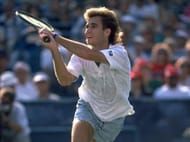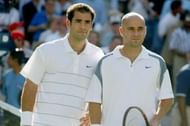The Laver Cup, considered golf's equivalent of the Ryder Cup, features the six best players from Europe pitted against their six best counterparts from the 'rest of the world'. The event celebrates the career Rod Laver, who remains the only player in the Open Era to win all four Grand Slam tournaments in the same calendar year (1969).
12 players from as many countries in Europe and 10 players from 5 non-European countries have played at the Laver Cup. 2017 Prague featured nine top-20 players (six for Team Europe and three for Team World). The number for 2018 Chicago was 10 (six for Team Europe and four for Team World). Geneva 2019 featured six top-20 players from the European team and one from the world team.
But two decades ago, had the Laver Cup existed, both Team World and Team Europe could have had an all-top 20-player line-up.
A Laver Cup in 1999
In a fictitious Laver Cup twenty years ago, the following players would have graced the competition for both teams.
Team World
#1 Andre Agassi, USA (Ranked 1)
#2 Pete Sampras, USA (Ranked 3)
#3 Gustavo Kuerten, Brazil (Ranked 5)
#4 Todd Martin, USA (Ranked 7)
#5 Patrick Rafter, Australia (Ranked 17)
#6 Mark Philippoussis, Australia (Ranked 19).
The two highest ranked Americans -- Agassi and Sampras, who have a combined tally of 17 Grand Slam titles (nine on hardcourt) -- should be the first picks in the team by captain Patrick McEnroe. Agassi is fresh off his second US Open title.

1997 French Open champion Gustavo Kuerten makes the team after a fine season in 1999, which saw him break into the top five and make consecutive non-clay Grand Slam quarterfinals at Wimbledon and the US Open.
Todd Martin makes the team after reaching his second (hardcourt) Grand Slam final, the latest being 1999 US Open, lost to Agassi in five sets). The American showed good hardcourt form during the year, a title in Sydney and a run to the Australian Open quarterfinal taking him to a career-high ranking of four.
Patrick Rafter is picked based on the Aussie's hardcourt prowess (won the 1997 and 98 US Opens), his first Wimbledon semis in 1999 and having held the world No 1 position (for a week) that year.
Mark Philippoussis is the last man picked by McEnroe to complete his team. The Aussie made his first Grand Slam final on a hardcourt (1998 Australian Open, lost to Rafter) and won his first Masters 1000 title at the 1999 Indian Wells, also on hardcourt). Philippoussis also made consecutive Wimbledon quarterfinals (1998 and 99).
Team Europe
#1 Yevgeniy Kafelnikov, Russia (Ranked 2)
#2 Thomas Enqvist, Sweden (Ranked 4)
#3 Nicolas Kiefer, Germany (Ranked 6)
#4 Richard Krajicek, Netherlands (Ranked 10)
#5 Tommy Haas, Germany (Ranked 11)
#6 Greg Rusedski, Great Britain (Ranked 14).
Captain Bjorn Borg, like his counterpart in the World Team, picks up four top-ten players in his team led by Yevgeniy Kafelnikov.

Kafelnikov picked up the second Grand Slam title of his career, first on hardcourt, at the Australian Open earlier in the season. The Russian comes into the Laver Cup after his maiden US Open semifinal, lost to eventual winner Agassi).
Borg's second pick is compatriot Thomas Enqvist, who made his maiden Grand Slam final earlier in the season -- the 1999 Australian Open, lost to Kafelnikov.
Nicolas Keifer is selected after winning his second hard-court title earlier in the season, in Tokyo (April 1999). 1996 Wimbledon champion Richard Krajicek is the fourth member with the Dutchman having won his first Masters 1000 title in Miami earlier in the season.
21-year-old Tommy Haas is the youngest member of Borg's Team Europe. The German made his maiden Grand Slam semifinal at the Australian Open earlier in the season (lost to eventual winner Kafelnikov). Haas won the first title of his career at the US Indoor Championships (hardcourt), where he beat Jim Courier in the final.
Greg Rusedski, with his big serves and hardcourt prowess (1997 US Open finalist, 1998 Miami finalist), completes Team Europe.
The '1999 Laver Cup'
Team World, with a combined tally of 11 hardcourt Grand Slam titles and 21 Grand Slam titles in total, would have packed quite a punch, while Team Europe, with a combined tally two hardcourt Grand Slam titles, would have been the underdogs.
With each team featuring four top-ten players, best-of-three set matches (with a match tiebreak instead of a third set) on an indoor hardcourt would have been closer than the ones at the 2019 Laver Cup in Geneva.
After the 1999 US Open, the six players from Team World had a cumulative match wins lead of 91-75 over their six counterparts from Team Europe.
In the 36 possible singles pairings, the two teams would have been tied in head-to-head leads (15-15), with Sampras enjoying head-to-head leads over five Europe players (except Krajicek) and Krajicek leading four world players on head-to-head.
In fact Krajicek did not have a losing head-to-head against any of the players from Team World, which included a 6-3 lead over Sampras, tied 3-3 with Agassi, a 1-0 lead over Kuerten, tied 1-1 with Martin, a 6-2 lead over Rafter, and a 2-1 lead over Philippoussis.
The world's top-ranked player Agassi had winning head-to-head leads against only two players (2-0 against Keifer, and 3-0 against Rusedski). Agassi trailed Enqvist 0-2 and Haas 1-2 while he was level with Kafelnikov and Krajicek after eight and six matches, respectively.
Each of the four other World players (Kuerten, Martin, Rafter, and Philippoussis) had losing head-to-head records against three players from Europe. Rusedski of Team Europe had a losing head-to-head against four World players (except Kuerten, against whom he led 3-1 and Philippoussis, 3-1).
Team captains John McEnroe (Team World) and Bjorn Borg (Team Europe) would have had their tasks cut out to pick the singles and doubles pairings.
Team Strategy
The format of the Laver Cup is such that the tie stays alive till the third day, even considering the unlikely scenario of one team sweeping all eight matches after two days of play.
With doubles fixtures carrying a quarter of the total points on offer, Rafter/Philippoussis for Team World against Kiefer/Haas from Team Europe would have resembled a Davis Cup doubles match between Australia and Germany, and could have been the marquee doubles match of the tie on Day 3, with the winner pocketing three valuable points for their team.

The enticing Agassi/Sampras pairing would have featured on one of the first two days to draw in the crowd but not on the third, as either or both players would be required in singles action.
The strategy in singles, for both captains, would have been to feature their respective marquee singles players, Sampras (Team World) and Krajicek (Team Europe) on the final day of action. This would have meant that an explosive big-serving match-up between Philippoussis and Rusedski would have materialized on the first two days.
A Laver Cup in 1999 would have been quite an exhilarating spectacle. With astute singles and doubles pairings, Team Europe would likely have sprung the 'upset' over their more fancied World counterparts.
What are Andre Agassi-Steffi Graf’s children doing now? Everything to know about Jaz & Jaden Agassi
